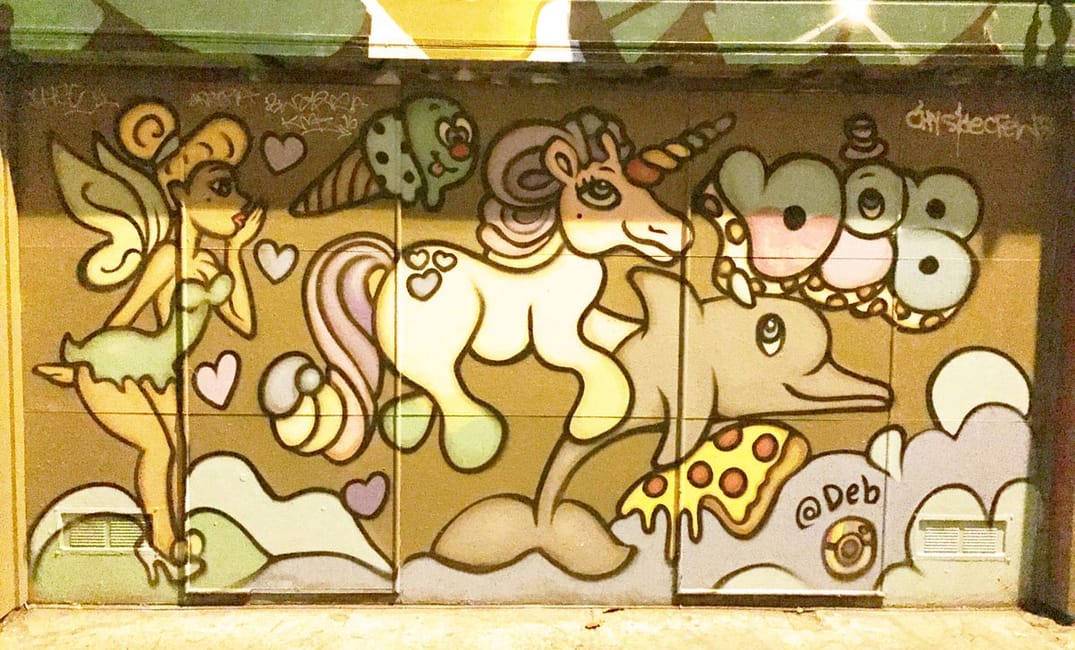
According to the National Museum of Women in the Arts, women make up just over half of all visual artists in the country today. Yet about only 30 percent of artists represented at commercial galleries are women. But street art presents an additional barrier of entry to women.
As street artist Caroline Caldwell told me, women street artists simply want to be recognized as artists rather than labeled as women artists. Yet gender makes a huge difference when you’re doing street art. Caldwell noticed this more when she first started creating street art outside. “My gender [m]ade me feel immensely vulnerable,” explained Caldwell. “Walking down the street felt like walking through a men’s locker room.” Unease in public space is a feeling that plenty of women can relate to, but for an artist who spends much more time in that space, the vulnerability is exacerbated: “Guys would follow me on the street, touch my hair and shout things at me from their car.”
When we don’t picture women as graffiti writers, those artists become invisible.
Of course, to be a muralist or a street artist, you have to endure these things: being in public spaces for long periods of time, often alone and at night. And for male street artists, it’s different. They’re less vulnerable. “Men are far less likely to be followed, harassed, assaulted, etc., when doing basic stuff like walking home from work,” Caldwell continued.
Because men generally don’t face the same vulnerabilities as women on the street do, male artists are able to spend more time comfortably honing their craft. “[Men] will have more practice time and advance faster,” said Caldwell. This could explain why women have been slower to gain prominence in the street-art world.
The gender imbalance may be even more pronounced when you look at graffiti. Dr. Jessica Pabón, a feminist scholar who grew up among graffiti writers, explained to me that graffiti and street art differ in many ways, though “the common assumption is that street art is an easier form for women because it is less subcultural, more accepted.”
The socially normalized idea of a graffiti writer or a street artist is gendered male — more specifically, a hoodie-clad vandal lurking through the night with a can of spray paint. As Pabón explained, “Gendered and racialized Western social conventions associate graffiti with criminality, criminality with masculinity, and masculinity with cisgendered men.” Pabón argues that when we don’t picture women as graffiti writers, those artists become invisible.
“We’ve been taught that graffiti is yet another activity we can chalk up to the idea that ‘boys will be boys,’” Pabón told me.
Every time a woman’s work is compared to a man’s — in order to size her up in relation to him — we are reinforcing barriers for women in the arts.
Likewise, the women who are street artists and graffiti writers are often written about in a demeaning way that compares them to the normalized image of the male street artist — people like Banksy. Since his rise to fame, the popular media has used Banksy as a focal point for other street artists, including women. Bambi, for example, has been called “the female Banksy.”
Caroline Caldwell responded to the way Banksy is used as a baseline, and her argument was spot on: the need to compare women to men in their field makes it even tougher for a woman doing serious street art to be taken as seriously as men doing the same thing.
Every time a woman’s work is compared to a man’s — in order to size her up in relation to him — we are reinforcing barriers for women in the arts. Thanks to slow-changing social norms, women in street art haven’t been evaluated on the basis of sheer merit, but rather on their gender, i.e., how good they are “for a girl.” Of course, this is not how women want to be seen. Bambi’s rejoinder to the “female Banksy” appellation was to refer to Banksy as “the male Bambi.”
Many women in street-art and graffiti circles are coming up with their own organic solutions to biases and vulnerabilities. Recently, women street artists have been able to form all-women graffiti crews, whereas it used to be more common for a woman to be one among a group of men. And graffiti writers and street artists alike are gathering together at events and in social media spaces online. With this burgeoning network to encourage women artists, there’s been a propulsion among women in street art. And, perhaps, when it comes time to go out to the street, a crew gives a woman not only an underlying support system but also strength in numbers.
Women street artists and graffiti writers share this frustration. According to Pabón, “A lot of these women do not want to be seen as ‘women.’…They are tired of getting asked ‘girl’ questions and want to be treated the same as men — no better, no less.”







